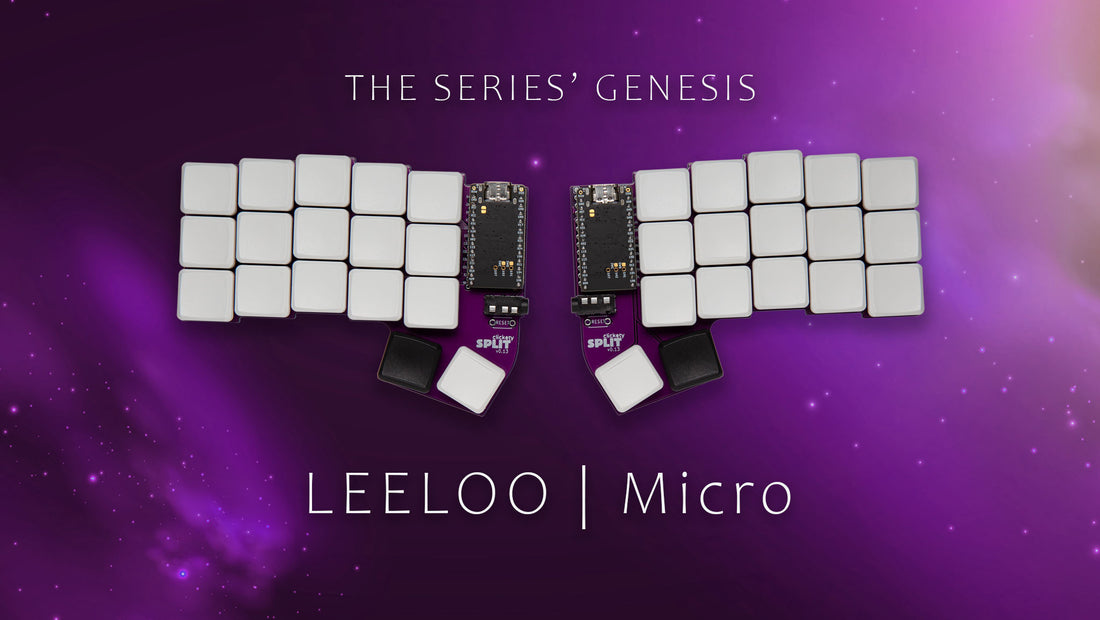
Leeloo | The Series’ Genesis
Share
My first “custom” keyboard was by WASD, mid-2014; it was 104 keys, with Cherry MX Green switches, all black and without legends. This keyboard was absolutely solid! It took care of me for many years, and still does.
In 2017, a good friend of mine, introduced me to his split keyboard collection: ErgoDox, Lily58, Corne, Pinky3, and Pinky4. My mind was absolutely blown, I’d not seen anything like them, let alone, typed with switches that were so clean and crisp! After borrowing his ErgoDox for a few weeks, I took the plunge and picked up a Kyria DIY Kit. It was a lot of fun to build, and I had a great time learning QMK. It was an amazing experience to customize the keymap to literally anything I wanted.
Alas…personal discovery.
After a few months, I found myself not using the thumb cluster as much as before. I opt to leverage layers vs reach for the outward most thumb keys. I really liked the rotary encoders just under my palms, because I found that I didn’t need to move my hands away from home row.
The other uncomfortable behaviour I found was that I’d needed to reach for the pinkie keys: A, Z, CAPS, LSFT, SCLN, SLSH, QUOT, and RSFT. I felt like I needed to pull and curl my pinkie fingers in and then out too much to hit the keys accurately.
In search for finding comfort, I decided to venture into creating my own layout. I suspect, like many curious custom keyboard enthusiasts, I pulled down the Corne, Lily58, Sofle, Ferris, and many others to see how they were designed. I remember looking at the schematics, and the PCBs—not knowing, nor understanding what was going on—it was quite intimidating…to be honest.
In order to understand what was going on, I took a couple of courses on electronics, and PCB design. While taking the courses, things slowly started to make sense. I dissected the Corne, Lily58, and Ferris Sweep because I felt they were very close to what I wanted for ergonomic feel.
I began by printing out the PCBs and pretending to type on them. I studied how my fingers rested on home row, and watched how my fingers would move as I typed: The quick brown fox jumped over the lazy dog.
I found that I really liked the keycap spacing of the Ferris, yet the stagger of the Corne and Lily58—with just a little tweak to the pinkie keys. I did try the Sofle for a while, but I found that there were too many modifier switches and my thumb either got lost, or it had to travel too far into my palm to hit the switch properly. And, curling in either my ring or middle finger was too awkward because it was like pressing the keys with the backs of my nails.
I couldn’t quite find the layout I wanted, so…I ventured into creating my own.
Enter, Leeloo.
The Process
The first question I asked myself was, “what do I want?”
I started with what I liked:
- Kailh Choc switches
- MBK Keycaps
- Choc Switch Spacing: 18mm
I then moved on to, “how many keys do I need?”
- 5x3 for typing
- 4 modifiers, would be nice
- 3 modifiers, required
- 1 rotary encoder, desired
The last question I needed to unpack was, “how much stagger from finger to finger?”
To be honest, this was the easiest of the questions to answer. It was the process of iterative testing:
- Create a grid of 5x3 18mm x 18mm squares in Adobe Illustrator.
- Adjust column stagger.
- Duplicate and mirror.
- Print 1:1.
- Test: The quick brown fox jumped over the lazy dog.
- Go back to step 2 until happy.
Now that I had a good place for home row, I worked on setting up the modifier keys.
Not too different a process:
- With fingers on home row, sweep thumb left and right, and without looking, stop where it feels natural.
- Mark position.
- Loop a few times until a consistent position is found.
- Place first modifier.
Subsequent modifier keys were placed along the natural arch of my thumb, while keeping 18mm spacing.
Back to my first question, “how many [modifier] keys do I need?”
This was difficult for me to answer because I didn’t really know. Because I wasn’t sure, I figured, least number of modifiers first…I followed in the footsteps of Ferris—two modifiers.
As far as the shape of the keyboard, I kept it as close to the switches as possible. I didn’t want the shape to influence the end result.
Not so surprisingly…it looked like the Corne, Lily58, and Ferris. With the exception to the natural placement of home row keys and the sweep of my thumbs.
The Study
So…that’s it? Perfection!
Well, not really. I tested the layout with a number of friends, family, and workmates. And, discovered two things. One, everyone is different…two, everyone has preferences.
LOL! Like this is a surprise to you.
Seriously, I really did learn two things. One, not everyone has the same home row finger placement. Two, not everyone has the same natural hand placement—let’s call it, “split keyboard distance, yaw, and cant.”
At first, I watched my test subjects type in their natural environment. They used their work or home keyboards, or even the keyboards on their notebooks/laptops. It was amazing to watch. I watched touch typists, hunt and peck typists, and even the kung fu, “three finger claw technique” typists.
Typists ranged from family, and friends who don’t type very much, to my workmates who code, and write many types of design documents.
The biggest variation I noticed while studying people’s hand movements was finger curl over home row. For those who preferred to use the pads of their fingers moved their arms and fingers more, and required more stagger. Those who had more curl, or used more of their fingertips had less movement altogether. In fact, very little arm movement, and very little finger movement.
When I introduced the split layout of 5x3, it was interesting to watch them find a comfortable distance, and yaw to each shield. When they found comfort, I asked them to try their best to curl their fingers over home row with their finger tips, and see if they could reach the keys above and below without moving anything but their fingers.
Interestingly, most would hit the keys without issue on the Choc spacing template I had them pretend to type on; yet, for some, MX spacing (19.05mm) was better.
Tangent: I had one question come up quite a bit, “where are the rest of the keys?” When this question came up, I shared the idea of Home Row Mods. How keys on the home row have multiple purposes or behaviours—Alt, Ctrl, GUI, and Shift. Along with this, the idea of layering; how we could split a typical full-sized keyboard into layers like Default, Lower, Raise, and Adjust.
Back from tangent: there definitely wasn’t a stagger that would fit them all, but I did notice that there was a strong average, of which was relatively symmetrical between hands.
I felt pretty good about the stagger and thumb sweep, so I rendered the Gerber files, and had my first keyboard shield produced…
Leeloo-Micro was born.
But wait! The title alluded to the Leeloo series.
There’s more to this story…there’s a trilogy in fact.
For now, not unlike how some movie editors like to tell their stories, we begin with the genesis, share with you what seems like the future, and then come back to share the middle-story.
The way that Leeloo was produced, its story unfolds the same way.
So...until next time!
Clickety Split
For the love of split keyboards.
